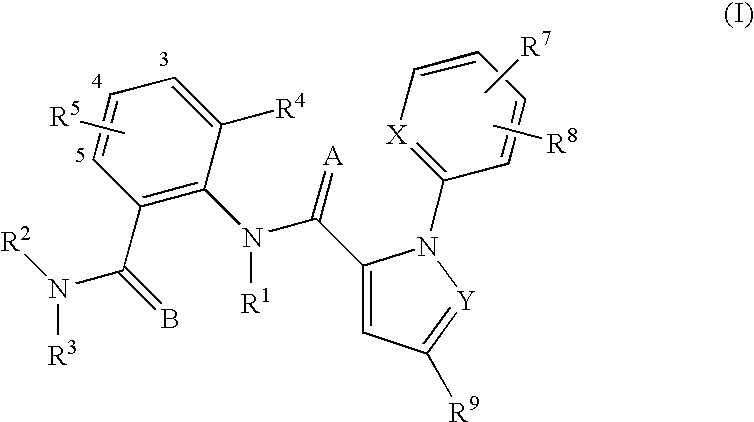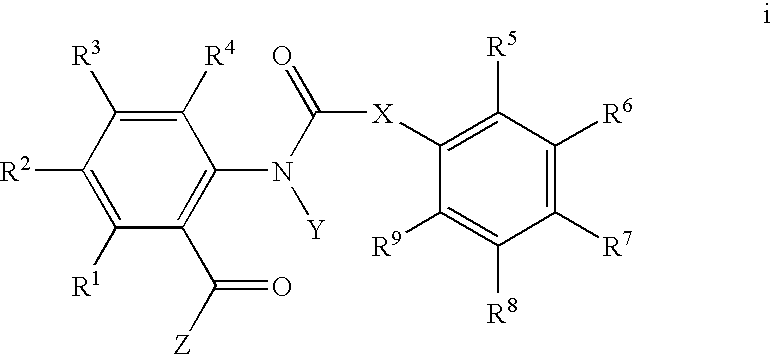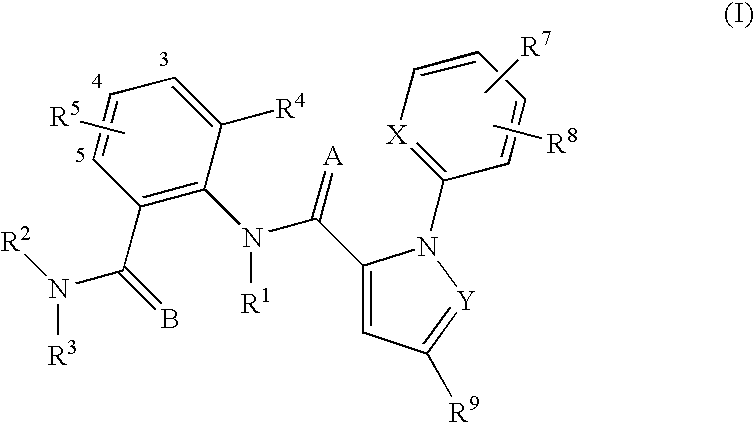Substituted anthranilamides for controlling invertebrate pests
anthranilamide and pesticide technology, applied in the field of substitution anthranilamides, can solve the problems of increased costs to consumers and significant productivity reduction
- Summary
- Abstract
- Description
- Claims
- Application Information
AI Technical Summary
Benefits of technology
Problems solved by technology
Method used
Image
Examples
example 1
Preparation of 1-[2-Hydroxymethyl)phenyl]-N-[2-methyl-6-[[(1-methylethyl)amino]carbonyl]phenyl]-3-(trifluoromethyl)-1H-pyrazole-5-carboxamide
Step A: Preparation of 1-[2-(methoxycarbonyl)phenyl]-3-(trifluoromethyl)-1H-pyrazole-5-carboxylic Acid
[0292]A solution of 1-[2-(methoxycarbonyl)phenyl]-3-(trifluoromethyl)-1H-pyrazole-5-carboxylic acid (8.0 g, WO 99 / 32545) in SOCl2 (100 mL) was heated to reflux for 3 hours. The reaction mixture was cooled and concentrated to give the crude acid chloride.
[0293]At 0° C., the crude acid chloride in 70 mL of acetone was added dropwise to a solution of 2-amino-3-methylbenzoic acid (4.11 g) and triethylamine (8.24 g) in 400 mL of acetone. The reaction mixture was stirred at 0° C. for 10 minutes and then warmed up to room temperature for 1.5 hours to form the title compound of Step A. The mixture containing this compound was carried directly to Step B.
Step B: Preparation of Methyl 2-[5-[[[2-methyl-6-[[(1-methylethyl)amino]carbonyl]phenyl]amino]carbony...
example 2
Preparation of Methyl 4-[[[1-(3-chloro-2-pyridinyl)-3-(trifluoromethyl)-1H-pyrazol-5-yl]carbonyl]amino]-3-methyl-5-[[(1-methylethyl)amino]carbonyl]benzoate
Step A: Preparation of 2-Amino-5-iodo-3-methylbenzoic Acid
[0297]2-Amino-3-methylbenzoic acid (10 g, 66 mmol) was dissolved in 70 mL of N,N-dimethyl-formamide (DMF) and treated with N-iodosuccinimide (16.4 g, 73 mmol). The mixture was heated at 60° C. for 17 hours and allowed to cool to 25° C. The mixture was diluted with water (150 mL and filtered. The air-dried solid was dissolved in ethyl acetate (200 mL) and dried over magnesium sulfate. Evaporation of the solvent provided the title compound of Step A (7.95 g). 1H NMR (CDCl3): δ 7.87 (1H), 7.44 (1H), 2.09 (3H).
Step B: Preparation of 2-[1-(3-Chloro-2-pyridinyl)-3-(trifluoromethyl)-1H-pyrazol-5-yl]-6-iodo-8-methyl-4H-3,1-benzoxazin-4-one
[0298]To methanesulfonyl chloride (1.64 g, 14.4 mmol) in acetonitrile (20 mL) at −5° C. was added 4 g (14 mmol) of 1-(3-chloro-2-pyridinyl)-3-(tr...
example 3
Preparation of N-[4-Acetyl-2-methyl-6-[[(1-methylethyl)amino]carbonyl]phenyl]-1-(3-chloro-2-pyridinyl)-3-(trifluoromethyl)-1H-pyrazole-5-carboxamide
[0301]The title compound of Example 2, Step C (0.7 g, 1.3 mmol) was dissolved in DMF (10 mL) and treated with tributyl-(1-ethoxyvinyl)tin (0.47 g, 1.3 mmol) and bis(triphenyl-phosphino)palladium dichloride (50 mg). The mixture was heated at 80° C. for 4 hours. The mixture was poured into water (50 mL) and extracted with ether (3×50 mL). The combined organic layers were washed with water (50 mL) and saturated brine (50 mL). The mixture was dried over magnesium sulfate and concentrated under reduced pressure. The residue was filtered through a silica gel cartridge using dichloromethane as eluent. The appropriate fractions were pooled and evaporated. The residue (400 mg) was dissolved in acetone (20 mL) and treated with 1N hydrochloric acid (5 mL). After 1 hour at 25° C. the reaction mixture was partitioned between ethyl acetate (50 ml) and...
PUM
 Login to View More
Login to View More Abstract
Description
Claims
Application Information
 Login to View More
Login to View More - R&D Engineer
- R&D Manager
- IP Professional
- Industry Leading Data Capabilities
- Powerful AI technology
- Patent DNA Extraction
Browse by: Latest US Patents, China's latest patents, Technical Efficacy Thesaurus, Application Domain, Technology Topic, Popular Technical Reports.
© 2024 PatSnap. All rights reserved.Legal|Privacy policy|Modern Slavery Act Transparency Statement|Sitemap|About US| Contact US: help@patsnap.com










